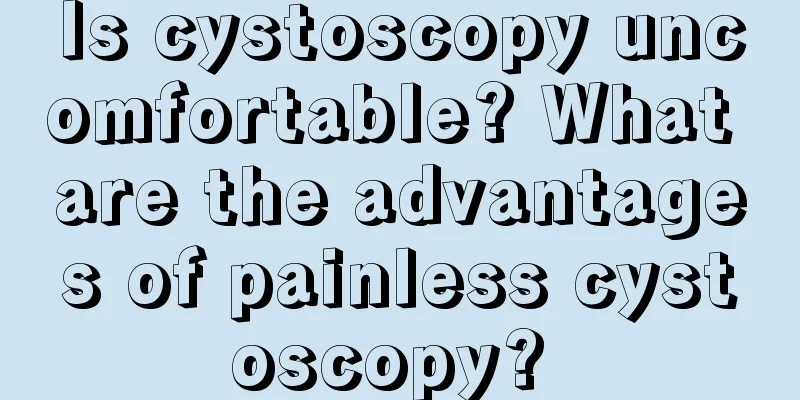Is cystoscopy uncomfortable? What are the advantages of painless cystoscopy?

|
In the past, traditional cystoscopy was very painful. With the advancement of current medical technology, painless cystoscopy has emerged. Painless cystoscopy has many advantages. Anesthesia is required before the examination, so that the patient will not feel pain during the examination in a very short period of time, and the adverse reactions after the operation are relatively mild. It is also more efficient and generally does not cause vomiting, nausea, low blood pressure and other adverse symptoms. 1. Traditional cystoscopy is extremely uncomfortable Cystoscopy is an examination method in which a cystoscope is inserted through the urethra into the bladder to directly observe lesions in the bladder and urethra. Previous cystoscopes were hard, and inserting them deep into the urethra was indeed a painful experience. 2. Big changes in flexible soft lenses Now that cystoscopes have become flexible cystoscopes, the situation has changed greatly. Under the operation of a skilled urologist, most patients only need to use a little local anesthetic to complete this examination. Some female patients (with wide, short and straight urethra) can even undergo cystoscopy without anesthesia. At present, cystoscopy is safe and a little painful, but it is tolerable and patients do not need to have too many concerns. 4. What is cystoscopy? Cystoscopy is an important means of diagnosing diseases in urology. During the examination, the doctor can observe the entire urethra and the conditions inside the bladder, such as urethral stenosis, prostatic hyperplasia, bladder neck contracture, etc.; tissue biopsy can be taken for pathological examination to confirm the disease; tumors that cannot be found by B-ultrasound or CT can also be found, especially flat-growing carcinoma in situ. Cystoscopy can not only help diagnose diseases, but doctors can also use it to treat some diseases, such as removing stones in the urethra or bladder, and foreign objects in the bladder. Advantages of painless cystoscopy 1. Painless: The patient does not feel any pain during the whole process of the examination 2. Short time: about 5-10 minutes, no need for hospitalization 3. High efficiency: treatment, stone removal and biopsy can all be completed during the examination 4. Mild postoperative reaction: Patients only have a small amount of hematuria or slight discomfort in urination after surgery 5. Since the patient is completely relaxed and cooperates with the treatment, there will be no damage to the urethral mucosa due to struggling, and the examiner can fully understand the lesion site without blind spots. 6. Some patients with poor physical conditions can also tolerate it without causing complications such as reflex nausea, vomiting, sweating, and decreased blood pressure, and there is a monitoring system throughout the process. Painless cystoscopy is safe, accurate, minimally invasive, and can be used for treatment at the same time. It is the most important and reliable examination method for diseases such as painless hematuria, bladder stones, and bladder tumors. It is also very suitable for patients who need to undergo long-term and multiple cystoscopy examinations after bladder cancer surgery. |
<<: How can rheumatoid arthritis be completely cured
>>: How to take care of your hair after perming it?
Recommend
How to use a wrist blood pressure monitor
Both young and old people must measure their bloo...
What harm does acetonitrile do to the human body
Acetonitrile is a chemical substance that is quit...
What are the diagnostic methods for breast cancer
Breast cancer is a serious disease for women. The...
Is there any hope for pancreatic cancer liver metastasis? Radiotherapy is the current treatment method
Pancreatic cancer is a malignant tumor of the dig...
What are the disadvantages of dentures
The problems that occur in our bodies in life are...
What are the dietary precautions for bladder cancer
Speaking of bladder cancer, I believe everyone ha...
What to do if the nail has pierced into the flesh due to paronychia
There are many people suffering from paronychia i...
Can hamburgers be put in the refrigerator
Hamburgers, an imported fast food, have long been...
What are the causes of high incidence of tongue cancer
In recent years, lobster restaurants have develop...
Characteristics of Iceland Pu'er Tea
As we all know, Pu'er tea is a specialty of Y...
Is it necessary to get Hib vaccine
Hib vaccines are generally divided into two types...
What are the diagnostic methods for pancreatic cancer?
Pancreatic cancer is a disease that makes everyon...
Regulation of insulin secretion
Insulin is secreted by pancreatic cells in the hu...
Does baking soda often contain small amounts of sodium chloride?
Speaking of baking soda, many people are familiar...
Various diagnostic methods for osteosarcoma
In addition to affecting the patient's physic...









